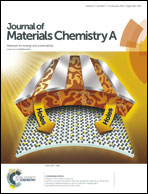Effect of a deposition container on the nanostructural growth and DSSC application of rutile TiO2†
Abstract
Various rutile TiO2 nanostructures were grown using a wet chemical deposition method within plastic, glass, stainless-steel, copper, silver, etc., containers and their application in DSSCs was envisaged for the first time. The reaction rate is different in different containers. The effect of container environment on the morphology and optical properties of rutile TiO2 was investigated and can be attributed to the presence of the respective container element in TiO2. The metals (copper, silver, iron, sodium, etc.) are confirmed (in wt%) in the final products. Due to a change in the morphology followed by absorbance, the power conversion and incident photon-to-electron conversion efficiencies are different (higher in the copper container at 1.97% and 16%, and lower in the stainless-steel container at 0.26% and 3%, respectively). This change in performance can be attributed to a difference in the electron life time values, which are consistent with the charge transfer and series resistance values obtained from Nyquist plots.


 Please wait while we load your content...
Please wait while we load your content...